 "You mean my fall porch decorations?! I would have no idea how to cook with them!"
"You mean my fall porch decorations?! I would have no idea how to cook with them!"
Is this you or someone you know? If so, you're not alone - we hear this all the time!
Now is the time to savor the goodness of winter squash, and we want to help you overcome any intimidation and give you inspiration on how to enjoy these curious winter vegetables!
To get things started, watch this quick video to see how easy it is to prepare our Egg in the Hole Acorn Squash - this is one of our favorites this time of year and during the holidays!
Egg in the Hole Acorn Squash with Krista Sanderson - KAKE
Summer squash vs. winter squash...what's the difference?
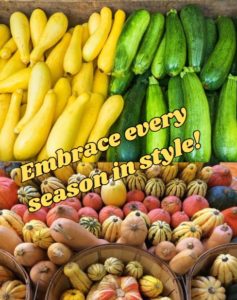 Summer squash, such as zucchini and yellow squash, are considered the "soft-skinned squash” or “tender squash" while winter squash could be considered the "hard-shelled squash." Summer squash is harvested from early to late summer and is meant to be enjoyed shortly after harvest and eaten raw, sautéed, grilled or steamed. Their skins are edible and also easily damaged. Because they are so perishable, they should be enjoyed within a few days of harvesting.
Summer squash, such as zucchini and yellow squash, are considered the "soft-skinned squash” or “tender squash" while winter squash could be considered the "hard-shelled squash." Summer squash is harvested from early to late summer and is meant to be enjoyed shortly after harvest and eaten raw, sautéed, grilled or steamed. Their skins are edible and also easily damaged. Because they are so perishable, they should be enjoyed within a few days of harvesting.
Winter squash, on the other hand, is harvested from late summer to early winter. Because of their thick skins, they are not as perishable and are ideal to store through the winter…hence, the name "winter squash." Winter squash is typically not eaten raw and, because of their thick flesh, require longer cooking times than summer squash. The skin is often removed from some varieties of winter squash before eating; however, the skin of other varieties can add a great texture and color, especially when you roast them.
Why is it important to eat winter squash frequently while it's in season?
All varieties of winter squash are a treasure trove of taste and textures, and they are also loaded with nutrients that skyrocket your health. Are they loaded with the phyto-nutrients that fight cancer? YES! Do they include the potassium and fiber that lower blood pressure and cholesterol? YES! Do they have minerals that build your bones even as well as milk? YES! Do they fill you up on less calories to naturally whittle your waist? YES! When we say winter squash is a superfood, we are not kidding!
What are the types of winter squash?
There are many varieties of winter squash. Here are some of the most popular and the ones that you are most likely to find at your local store or farmers’ market.
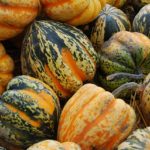 Acorn squash: has a subtly sweet and nutty flavor...and yes, you can eat the skin! They typically have a green skin, although you may also come across a variety with a white skin. Our favorite way to enjoy acorn squash is to roast it in the oven.
Acorn squash: has a subtly sweet and nutty flavor...and yes, you can eat the skin! They typically have a green skin, although you may also come across a variety with a white skin. Our favorite way to enjoy acorn squash is to roast it in the oven.
Try the Roasted Acorn Squash with Garlic and Pine Nuts, the Acorn Squash and Apple Salad, or the Maple Roasted Acorn Squash.
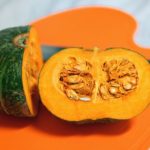 Buttercup squash (this is not a type-o, buttercup squash is different than butternut squash!): short and round, buttercup squash has an inedible dark green rind and vibrant orange flesh. It is similar to a kabocha squash but has a round ridge on the bottom.
Buttercup squash (this is not a type-o, buttercup squash is different than butternut squash!): short and round, buttercup squash has an inedible dark green rind and vibrant orange flesh. It is similar to a kabocha squash but has a round ridge on the bottom.
Buttercup is considered sweeter than many other winter squash varieties with its sweet creamy flavor. Steaming and baking is best for buttercup squash because its flesh can tend to be dry. It also works great in curry dishes like the Moroccan Vegetable Curry.
 Butternut squash: this pear-shaped squash is the sweetest variety of all of the winter squash, and the most versatile and most popular. One of my favorite stories is when we were sampling the Fire Roasted Sloppy Joes and we were telling someone what was in them. When we mentioned the butternut squash, she said, "Oh, I can't have that, I'm allergic to nuts." It just goes to show you don't know what you don't know!
Butternut squash: this pear-shaped squash is the sweetest variety of all of the winter squash, and the most versatile and most popular. One of my favorite stories is when we were sampling the Fire Roasted Sloppy Joes and we were telling someone what was in them. When we mentioned the butternut squash, she said, "Oh, I can't have that, I'm allergic to nuts." It just goes to show you don't know what you don't know!
There are tons of ideas for butternut squash on Eat REAL America…some of our favorites are Fire-Roasted Sloppy Joes, Butternut Squash Tacos, Very Veggie Minestrone, Butternut Squash and Fig Pasta, Butternut Squash Shakshuka, Roasted Butternut Squash and Pesto Grilled Cheese, Moroccan Butternut Squash and Quinoa, and the Pear and Butternut Squash Salad. We even have a Butternut Squash Lasagna that was requested by an Eat REAL America member!
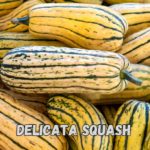 Delicata squash: also known as the "sweet potato squash," this squash is shaped like a small cylinder and typically has yellow or cream-colored skin with green stripes.
Delicata squash: also known as the "sweet potato squash," this squash is shaped like a small cylinder and typically has yellow or cream-colored skin with green stripes.
The skin of the delicata squash is edible and they are excellent for stuffing -- try our Stuffed Squash Taco Boats. And another favorite is the Sautéed Squash with Oranges and Pistachios.
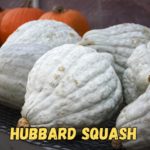 Hubbard squash: largest variety of all the winter squash -- hubbard squash are typically deep green to gray or blue and are most often sold at farmers' markets because of their size.
Hubbard squash: largest variety of all the winter squash -- hubbard squash are typically deep green to gray or blue and are most often sold at farmers' markets because of their size.
When sold at the store, they are often sold pre-cut and seeded. Hubbard squash have a rich, sweet pumpkin flavor and are an excellent substitute for any other type of winter squash in recipes. Try it in the Autumn Minestrone Soup or the Slow Cooker Curried Winter Squash Chili.
 Kabocha squash: short, squatty and round, and very similar to buttercup squash. Kabocha squash will have a dull finish with dark green skin, and sometimes will have small lumps.
Kabocha squash: short, squatty and round, and very similar to buttercup squash. Kabocha squash will have a dull finish with dark green skin, and sometimes will have small lumps.
They have a bright yellow-orange flesh inside and are also a great substitute for any other winter squash. This type of squash works great as a pie filling! Give it a try in the Roasted Squash and Spicy Onions or the Slow Cooker Thai Chicken Stew.
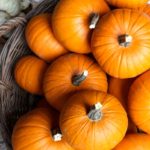 Pumpkin: not just for decorating! The pumpkins used for baking are smaller than the ones for decorating.
Pumpkin: not just for decorating! The pumpkins used for baking are smaller than the ones for decorating.
For the best flavor and texture, choose varieties that are grown for eating such as sugar pumpkins, sweet pumpkins, cheese pumpkins, and different heirloom varieties. Try it with the Fall Pumpkin Salad or the Spiced Middle Eastern Butternut Squash (using pumpkin instead).
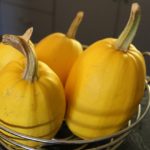 Spaghetti squash: the most fascinating squash of all (for kids and adults!) -- and the easiest way to turn a vegetable into noodles! This squash is fairly large and cylinder-shaped. It is pale cream to bright yellow on the outside.
Spaghetti squash: the most fascinating squash of all (for kids and adults!) -- and the easiest way to turn a vegetable into noodles! This squash is fairly large and cylinder-shaped. It is pale cream to bright yellow on the outside.
When cooked, the inside of the squash easily shreds into noodles, like spaghetti. The squash noodles are crisp-tender, with a mild flavor. They are not too sweet which makes them an excellent vegetable substitute for pasta. See our coaching tip for more info!
And Eat REAL America is loaded with ideas for how to enjoy spaghetti squash - just a few include the Spaghetti Squash Noodle Bowl (one of Zonya's favorites!), Spaghetti Squash Pad Thai, Mexican Spaghetti Squash Stir Fry, and the Spaghetti Squash Hash. Believe it or not, we even have Spaghetti Squash Pancakes!
How do you pick and choose winter squash?
- The stem is the best indicator of ripeness. It should be intact, firm, dry and cork-like. If a stem is leaking sap, it means it was harvested before it was ready.
- They should feel firm and heavy for their size.
- No soft spots, bruises or cuts.
- They should have a dull, not shiny, finish. Shiny skin means the squash was likely picked too early.
How do you store winter squash?
You want to store winter squash in a cool dark place, and most of them will keep easily for up to one month or longer!
- Acorn and spaghetti squash: one month
- Butternut squash: 2-3 months
- Hubbard, banana, buttercup or turban: 3-6 months
How do you peel and cut winter squash?
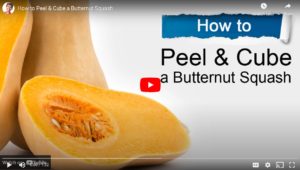 In our experience, the easiest way to cut a winter squash is with a large knife, such as a chef's knife. If you find it too hard to cut, you can put it in the microwave for a couple minutes to soften it up slightly and take the edge off. First, cut the ends off the squash, then cut it in half, or in manageable pieces. Use a spoon to scoop out the seeds. You can then use a knife (or a rock star vegetable peeler if you have one) to remove the skin if desired. You are then ready to cut the squash in bite size pieces or slices for your recipe. We have tips on the website for how to cut a butternut squash and a spaghetti squash.
In our experience, the easiest way to cut a winter squash is with a large knife, such as a chef's knife. If you find it too hard to cut, you can put it in the microwave for a couple minutes to soften it up slightly and take the edge off. First, cut the ends off the squash, then cut it in half, or in manageable pieces. Use a spoon to scoop out the seeds. You can then use a knife (or a rock star vegetable peeler if you have one) to remove the skin if desired. You are then ready to cut the squash in bite size pieces or slices for your recipe. We have tips on the website for how to cut a butternut squash and a spaghetti squash.
Don't toss those seeds! The squash seeds are loaded with protein, fiber and zinc and can be a delicious snack when dried and roasted. And, it's so easy...simply rinse and dry. Then, toss with a little olive oil and salt (and whatever other seasonings you are craving). Place on a baking sheet and roast in the oven (250 to 300 degrees), for about 10 minutes until toasted and lightly browned. Let cool then store in an airtight container, they will stay fresh for several days.
Even more ways to enjoy them!
By now, you know the benefits of getting a wide variety of in-season fruits and veggies! There are some fun and delicious ways you can enjoy multiple varieties of winter squash in one meal. Check out this video on how to enjoy butternut squash and spaghetti squash in the Quick and Easy: Fire Roasted Sloppy Joes!
 Other great ideas include the Autumn Roasted Veggie Sandwich and the Sweet and Sour Winter Squash!
Other great ideas include the Autumn Roasted Veggie Sandwich and the Sweet and Sour Winter Squash!
Especially the next few weeks, challenge yourself to try different varieties of winter squash and new and different ways! You may experience something similar to one of our Eat REAL America members who told us she never thought she liked butternut squash (she thought it was "creepy"), because her mom never prepared it when she was growing up. She tried roasting it in the oven and said, "I never knew what I was missing, and now I absolutely love it!"
Share your results with us!
What is your favorite way to enjoy winter squash?

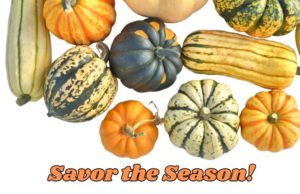

I just bought a honeynut squash for the first time on Sunday. It’s a hybrid between a buttercup and a butternut. Debating between just roasting it or making a soup or making the Moroccan butternut squash and quinoa.
I had this for the first time last week. I roasted it with olive oil, salt, pepper and cinnamon. I diced one of them and just cut the other one in half and both versions turned out well. Hubby said it tasted like dessert! Very tasty.
Krista! That interview was soooo fantastic. It looked so delicious, steps well and succinctly explained and perfect play with the host…you are a PRO of all PROs! Way to go!
All time fall favorite is Butternut squash soup. Roast it with a couple of sweet potatoes, then add it to traditional soup mix of sauteed carrots, celery and onion. Add in vegetable broth simmer and using my immersion blender it is creamy and dreamy.
Thank you, Krista, for the education on Winter Squash. There were a couple I didn’t know about and will look for at my market.
Happy Fall Harvest.
I like winter squashes and my favorite is butternut squash. I love to use butternut squash to make soups and in a roasted veggie dish. Thank you for this article and all the information on other squashes I have yet to try.
You are so welcome – keep us posted if you experience more favorites! If you are like us, acorn squash will be added to your favorites list!